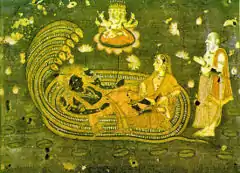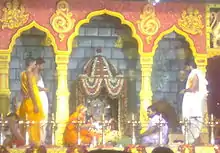Chaturmas
Chaturmas (Sanskrit: चातुर्मास, Cāturmāsa) is a holy period of four months (July to October), beginning on Shayani Ekadashi—the eleventh day of the bright half, Shukla paksha, of Ashadh (fourth month of the Hindu lunar calendar)—until Prabodhini Ekadashi, the eleventh day of the bright half of Kartik (eighth month of the Hindu lunar calendar) in Hinduism.
| Chaturmas | |
|---|---|
 Vishnu sleeps on the Shesha Shaiya—bed of Shesha. | |
| Begins | Shayani Ekadashi |
| Ends | Prabodhini Ekadashi |
| Frequency | annual |
Chaturmas is reserved for penance, austerities, fasting, bathing in holy rivers and religious observances for all. Devotees resolve to observe some form of vow, be it of silence or abstaining from a favourite food item, or having only a single meal in a day.
Etymology
Chaturmas literally means "four months", derived from the Sanskrit catur (चतुर्), "four",[1] and māsa (मासः), "month".[2]
Zodiac Interpretation
The sun enters the zodiacal sign of Karka (Cancer) and begins to move southwards in the month of Ashadh.
Hinduism
The eleventh day of Ashadh is called Devashayani Ekadashi, because in Hinduism, Devas (demigods) are believed to begin to sleep on this day. They are believed to wake up on the eleventh of Kartik, hence called Prabodhini Ekadashi. The period corresponds with the rainy season in India.[3]
It is believed that Devas are at rest during this period and should not be disturbed, so no auspicious ceremonies, such as weddings and thread ceremonies, are held during the four months' period.[4]
Significance for householders
Chaturmas, inauspicious for weddings and other celebrations,[3] is a suitable time for householders to have an annual renewal of faith by listening to discourses on dharma, and by meditation and vrata (self-control). Penance, austerities, religious observances, recital of mantras, bathing in holy rivers, performing sacrifices, and charity are prescribed. Fasts and purity during this period help maintain health, for which there is likely a scientific rationale, disease spreading more readily with the onset of monsoon.
A number of Hindus, particularly those following the Vaishnav tradition, refrain from eating onions and garlic during this period.[5] In Maharashtra, a number of Hindu families also do not eat any egg plant (Brinjal / Aubergene) preparations.
Significance for Sanyasis

The Sanyasis or ascetics observe Chaturmas for four fortnights, beginning on full moon day of the month of Ashadh, also known as Guru Purnima or Vyas Purnima, and ending on full moon day of the month of Bhadrapada.[6] Sanyasis are supposed to halt during this period at one selected place (Rains Retreat), and give discourses to the public.
Celebrations
Major Celebrations within this holy period include:
- Guru Purnima
- Krishna Janmashtami
- Raksha Bandhan
- Ganesh Chaturthi
- Navratri (Dasahra – Durga Puja – Vijayadashami)
- Diwali
- Champa Sashthi (Margashirsha bright 6th ) - Per custom in Maharashtra, Chaturmas ends on this day.
Jainism
In Jainism this practice is collectively known as Varshayog and is prescribed for Jain monasticism.[7] Wandering monks such as mendicants and ascetics in Jainism, believe that during the rainy season, countless bugs, insects and tiny creatures that cannot be seen in the naked eye take birth massively. Therefore, these monks reduce the amount of harm they do to other creatures so they opt to stay in a single place for the four months to incur minimal harm to other lives. These monks, who generally do not stay in one place for long(59 nights for females, 29 nights for males), observe their annual 'Rains Retreat' during this period, by living in one place during the entire period amidst lay people, observing a vow of silence (mauna), meditation, fasting and other austerities, and also giving religious discourses to the local public.
During the four-month rainy-season period, when the mendicants must stay in one place, the chief sadhu of every group gives a daily sermon (pravacana, vyakhyana), attended mostly by women and older, retired men, but on special days by most of the lay congregation. During their eight months of travel, the sadhus give sermons whenever requested, most often when they come to a new village or town in their travels.[8]
One of the most important Jain festivals, Paryushana, falls during the beginning of this period, which concludes with Forgiveness Day, Kshamavani Diwas, wherein lay people and disciples say Micchami Dukkadam and ask forgiveness from each other.[9] Amongst Jain merchants, there is a tradition of inviting monks to their respective cities during Chaturmas to give religious instruction.[10]
In Jainism, the third part of the classical Jain text Kalpa Sutra, written by Bhadrabahu I in the 1st century AD, deals with rules for ascetics and laws during the four months (chaturmas) of the rainy season, when ascetics temporarily abandon their wandering life and settle down amidst the laity. This is the time when the festival of Paryushan is celebrated and the Kalpasutra is traditionally recited.
Buddhism
Gautama Buddha stayed at the royal garden of King Bimbisara of Rajgir, whom he had recently converted, for the period of Chaturmas and gave sermons: this practice is followed by monks to this day. Another reason for ascetics to stay in one place during the rainy season is that the tropical climate produces a large number of insects, which would be trampled by travelling monks.<
Vassa is varsha-vas i.e. three-month annual stay observed by Theravada monks. It begins with Asalha Puja. At the end of Bassa, during Kathina, new robes are donated by the laity to the monks.
Notes
- "Spken Sanskrit". Retrieved 6 July 2009.
- "Spoken Sanskrit". Retrieved 6 July 2009.
- Eleanor Zelliot, Maxine Berntsen (ed.). The Experience of Hinduism. SUNY Press. p. 335. ISBN 978-0-88706-662-7.
- Bhalla, Prem P. (2006). Hindu Rites, Rituals, Customs and Traditions. p. 293.
- J. Gordon Melton (2011). Religious Celebrations: L-Z. ABC-CLIO. pp. 172–173. ISBN 978-1-59884-205-0.
- Sampurna Chaturmas in Marathi
- Sangave, Vilas Adinath, Facets of Jainology: selected research papers on Jain society, religion, and culture, Popular Prakashan, p. 139, ISBN 81-7154-839-3
- Cort 2001, p. 104.
- Roy, Christian (2005). Traditional festivals: a multicultural encyclopedia, Volume 1. ABC-CLIO. p. 356. ISBN 1-57607-089-1.
- Mehta, Makrand (1991). Indian merchants and entrepreneurs in historical perspective: with special reference to shroffs of Gujarat, 17th to 19th centuries. Academic Foundation. p. 98. ISBN 81-7188-017-7.
References
- Cort, John E. (2001), Jains in the World : Religious Values and Ideology in India, Oxford University Press, ISBN 0-19-513234-3

